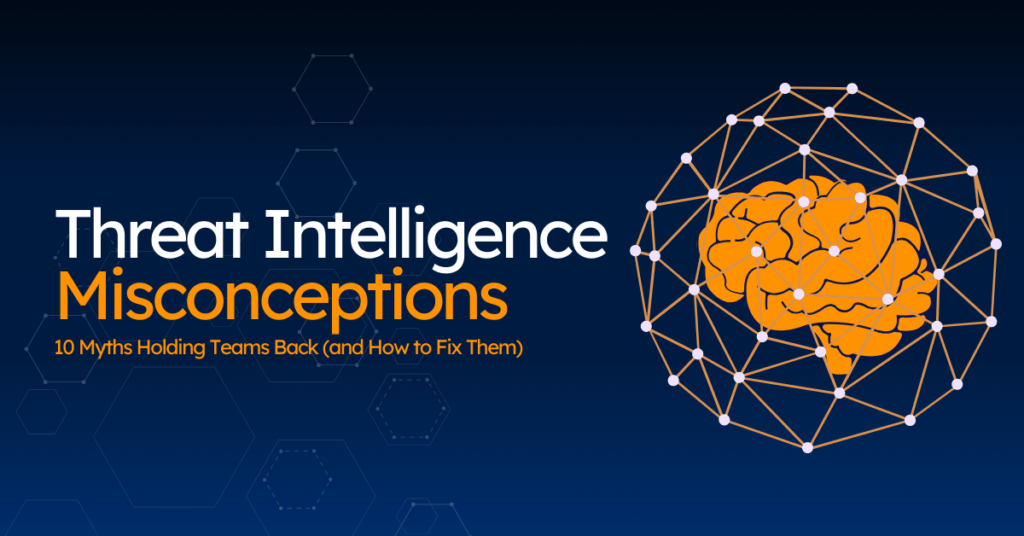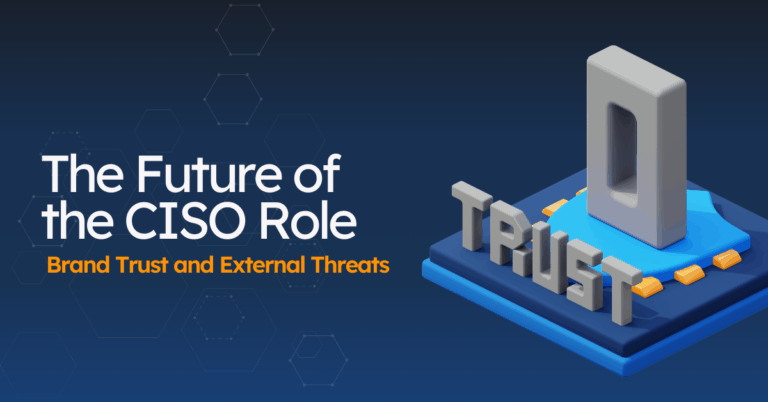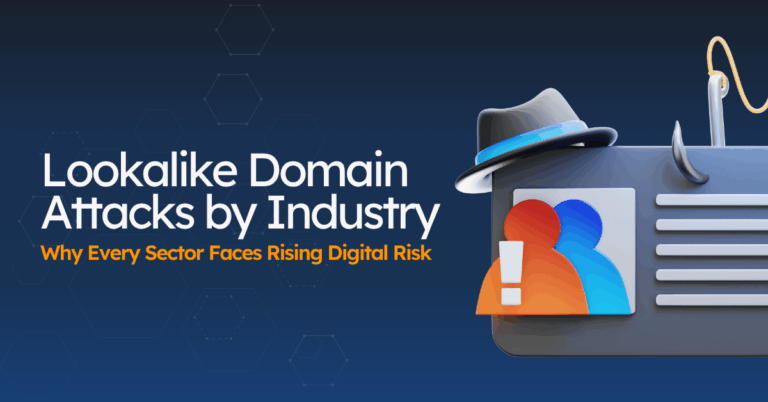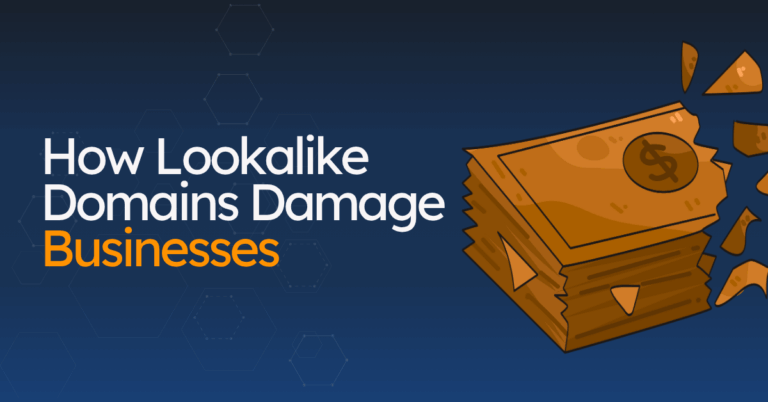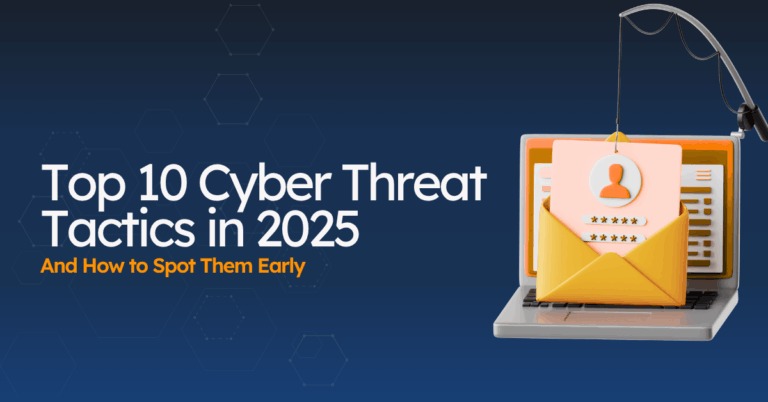Start Here: What Threat Intelligence Does
Before we hit the biggest threat intelligence misconceptions, here’s what threat intelligence actually does… in plain English.
Threat intelligence turns raw signals into decisions and action.
Not more alerts. Better choices.
What it changes for your team
- Earlier detection: You spot real threats before they spread.
- Clear priorities: You work on what matters, not what’s loud.
- Faster response: You know who’s behind it and what to do next.
- Better communication: You can explain risk to leadership in business terms.
What it is (and isn’t)
- Is: curated findings about real attackers, tools, and campaigns, tied to your assets and industry.
- Isn’t: a pile of feeds, a new dashboard, or a dump of bad IPs with no context.
Where it helps today
- Brand & executive protection: Find fake profiles, scam sites, and lookalike domains fast, and take them down. Learn more about executive protection.
- Credential leaks: Catch exposed logins on forums and markets, reset and contain before they’re used.
- Vulnerability triage: Patch the flaws attackers actually exploit in the wild, not just the ones trending.
- Third-party breaches: See vendor exposure early, reduce knock-on risk to your data and customers.
- Incident response: Enrich alerts with attacker behaviour, infrastructure, and next-step guidance.
Read more: Threat Intelligence for Security Teams: The Ultimate Guide
The Biggest Threat Intelligence Misconceptions And How To Fix Them
Below are the threat intelligence misconceptions that waste time and money, along with recommendations on what to do instead. Keep it simple. Make it useful.
Misconception 1: All feeds are the same
Reality: Feeds differ in source quality, update cadence, and evidence. Some repeat stale indicators. Others include rich context and fresh sightings.
What to do:
- Score sources weekly for freshness, precision, and coverage.
- Keep a short allowlist of high performers. Remove the rest.
- Require evidence fields per indicator. First seen, last seen, sightings, origin.
Misconception 2: More data equals more security
Reality: Volume without relevance creates noise. Noise hides real threats and slows response.
What to do:
- Deduplicate at ingest. Collapse overlaps by indicator and source.
- Expire stale items fast. Short TTL for noisy types, longer for high fidelity.
- Filter to your assets, brands, geos, and suppliers.
Misconception 3: Threat intelligence equals buying feeds
Reality: Feeds are inputs. Intelligence is analysis tied to action and ownership.
What to do:
- Start with questions. Who targets your industry? Which brands face abuse? Which CVEs see real exploitation?
- Map outputs to owners and systems. SIEM rules, EDR blocks, takedown queues.
- Define SLAs for triage and response. Measure performance.
Misconception 4: Automation replaces analysts
Reality: Automation handles scale. Analysts deliver judgment and correlation.
What to do:
- Automate ingestion, normalization, enrichment, scoring, ticketing.
- Route clear cases to automation. Escalate edge cases to humans.
- Preserve analyst time for hunting, campaign linkage, and executive briefings.
Misconception 5: Blocking the base domain is enough
Reality: Threats live under subdomains and paths, often on shared hosts and CDNs.
What to do:
- Block at URL path where safe. Use reputation for shared infrastructure.
- Maintain allowlists for business services.
- Stage controls in log only. Review hits, then enforce.

Misconception 6: Blocklists are risky and break traffic
Reality: Blind enforcement creates risk. Tested enforcement reduces risk.
What to do:
- Start in log-only. Review hits with context.
- Tune by country, network owner, and service. Exclude partners.
- Rotate entries. Age out items with no sightings. Track false positives.
Misconception 7: Everyone needs the same intelligence
Reality: Industry, stack, and geography drive different needs.
What to do:
- Align collections to your assets, suppliers, brands, and executives.
- Build watchlists for domains, mobile apps, social handles, and key people.
- Prioritize actor sets and TTPs seen in your sector.
Misconception 8: Dark web access is illegal
Reality: Access is legal in the United States, Canada, and the United Kingdom. Crimes are illegal there.
What to do:
- Monitor with strict scope and tooling. Collect only. Do not engage. Learn more: What is Dark Web Monitoring?
- Protect analyst identity with dedicated browsers, VPNs, and opsec.
- Involve legal and compliance on scope and retention.
Misconception 9: Only large enterprises benefit
Reality: Small teams gain strong value from focus and clear ownership.
What to do:
- Start with two use cases. Domain abuse and credential leaks work well.
- Add exploitation tracking for priority CVEs next.
- Expand once owners and SLAs hold steady.
Misconception 10: ROI is vague
Reality: Outcomes are measurable and tied to time saved and risk reduced.
What to do:
- Track mean time to detect and respond.
- Track takedown time, reset time, and alert enrichment rate.
- Report incidents prevented or contained, plus analyst hours saved.
What Good Threat Intelligence Looks Like
Strong intelligence is clear, current, and tied to action. Use this checklist to set the bar and keep it there.
Threat Intelligence Core qualities
1. Fresh
Attackers move fast. Indicators lose value in days, sometimes hours. Age items out on a schedule. Prefer sources with frequent, proven updates.
2. Accurate
False positives drain time. Track error rates by source and type. Fix the cause or remove the source. Reward feeds that stay precise over time.
3. Relevant
Intelligence should match your assets, brands, tech stack, geography, and industry. If an item does not map to your world, filter it out early.
4. Contextual
Data becomes useful when you know who, what, where, and how. Include threat actor hints, lures, hosting, and timing. Explain why it matters to you.
5. Actionable
Every item needs a next step, an owner, and a place to execute. Block it, hunt for it, or take it down. If no action follows, review why the item exists.
6. Timely
Delivery must match the use case. SOC alerts need minutes. Executive updates need days. Set targets and measure them.
7. Consistent
Fields, formats, and scoring should look the same across sources. Consistency speeds triage, automation, and reporting.
8. Traceable
You must know where each indicator came from and when. Keep provenance, sightings, and confidence visible. This builds trust in decisions.
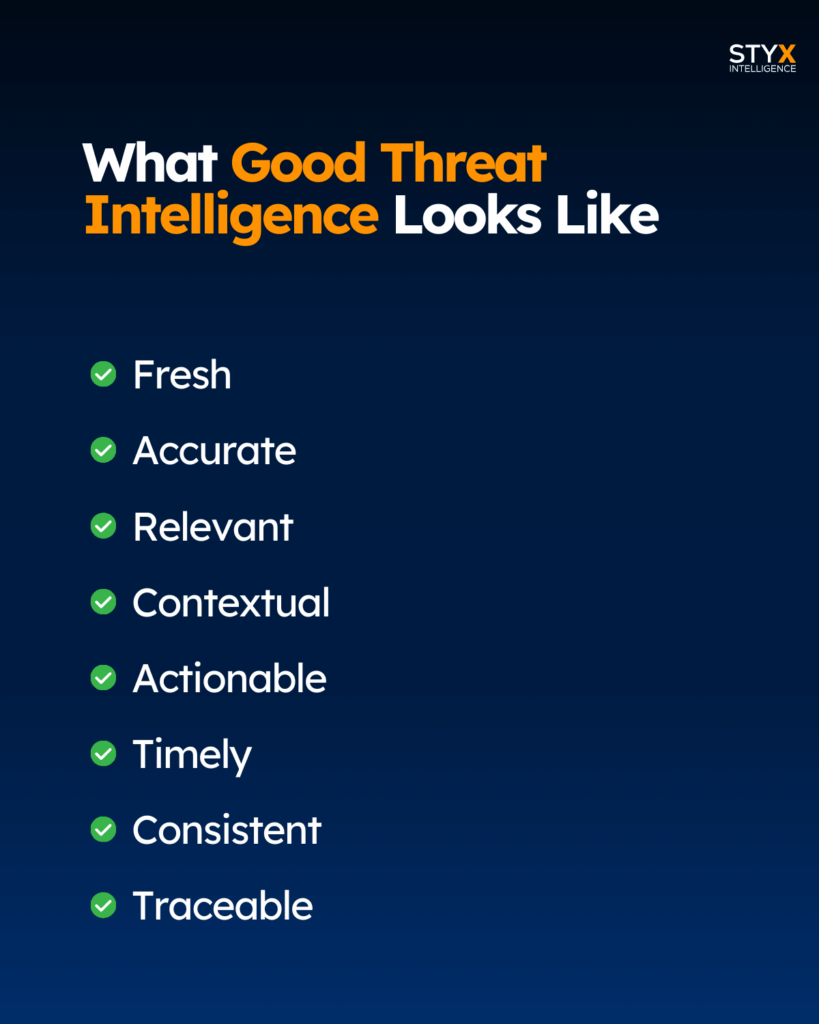
Quick tests to run on your intel
- De-duplication rate: Are you removing repeats across sources?
- Enrichment coverage: Do alerts include geo, ASN, malware family, threat actor, and first/last seen?
- Time to decision: Can an analyst act in under 5 minutes?
- Playbook hit rate: % of alerts that match a predefined response path.
- Outcome tracking: Closed as true positive, false positive, or informational — with reason.
Red flags (fix or drop)
- Stale indicators with no end-of-life.
- Hits with no evidence or screenshots.
- “Global” severity with no link to your environment.
- Feeds that spike volume but don’t change actions.
When intel is fresh, accurate, relevant, contextual, and actionable, teams move faster and waste less time.
What Your Threat Intelligence Platform Should Handle For You
You shouldn’t have to stitch this together. A good platform covers it end-to-end and routes clean, evidence-rich alerts to the right owners.
Coverage
- Surface web: lookalike domains, fake sites, scam ads, public posts.
- Social & apps: executive impersonation, fake support, rogue apps.
- Deep & dark web: credential leaks, data for sale, access listings, actor chatter.
- Third-party risk: vendor breaches and mentions tied to your data.
- Exploitation watch: CVEs actively used against the software you run.
Detection & prioritization
- Matches findings to your domains, brands, exec names, and stack.
- Scores risk by business impact, not just volume.
- Collapses duplicates and expires stale items automatically.
Evidence on every alert
- Screenshots, full URLs/handles, first-seen/last-seen, sightings, hosting details.
- Clear “why it matters” tied to your assets.
Built-in action
- One-click takedowns for domains, social profiles, and rogue apps.
- Credential leak workflows with forced resets and user notice.
- Prebuilt playbooks: block, reset, takedown, notify.
- Case tracking so you can see progress and outcomes.
- Takedown SLAs: track request/response times with an audit trail.
Integrations
- Sends enriched alerts to SIEM, EDR, email, and ticketing (Jira, ServiceNow).
- Role-based views for security, comms, legal, and leadership.
Governance & safety
- Legal-safe dark web collection with scoped monitoring.
- Audit trail of sources, evidence, and actions.

What You Should See When It’s Working
This is how results show up when threat intelligence is done right.
- Fewer noisy alerts. You spend less time filtering and more time fixing real problems.
- Faster detection. Brand abuse and credential leaks show up quickly, with proof attached.
- Quicker takedowns. Fake sites and profiles come down faster because cases are complete on the first pass.
- Cleaner resets. Exposed accounts get closed off within hours, not days.
- Better focus. Patching targets what attackers actually exploit in your environment.
- Simple reporting. One page each month: time to detect, time to fix, noise cut, incidents avoided, hours saved.
See a live view of your exposure and how fast it gets taken down. Book a demo with our team.

